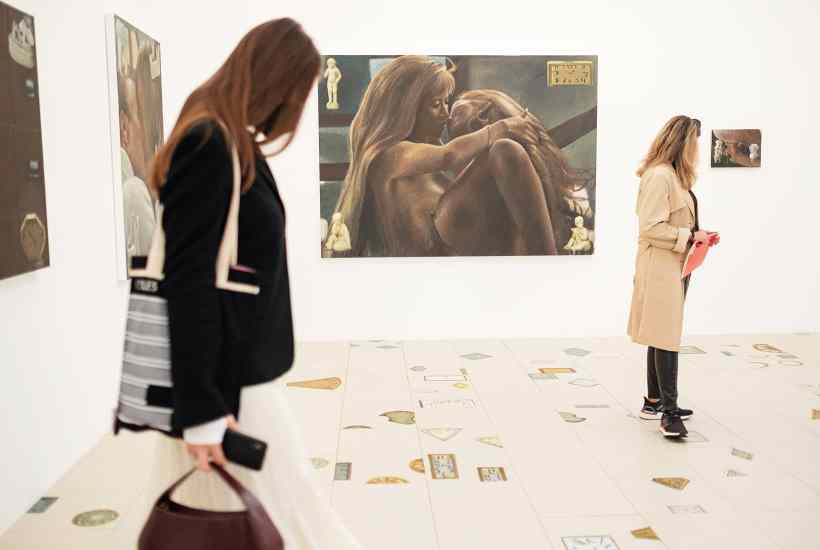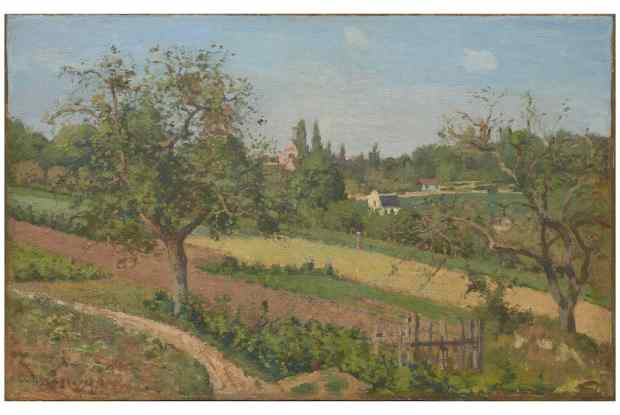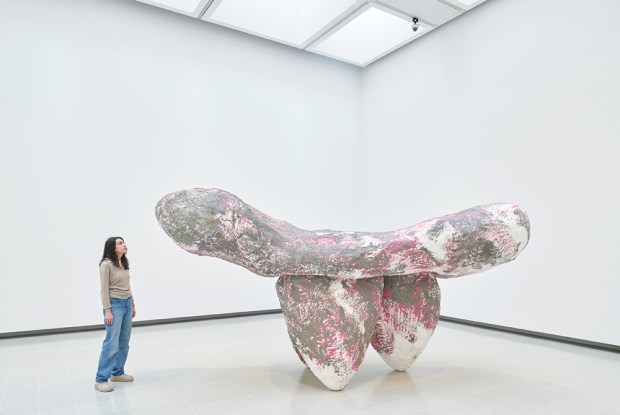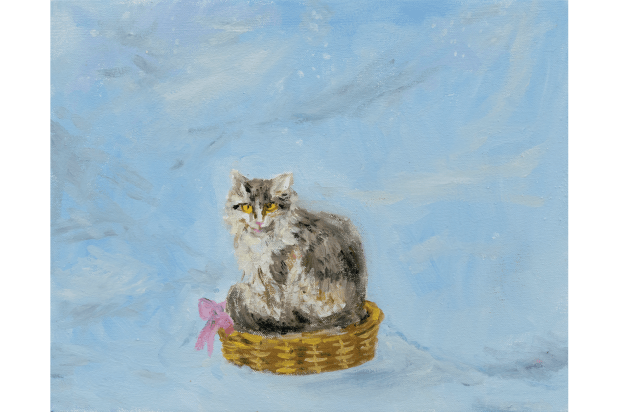There’s a faint scent of desperation wafting through the Frieze tent this year. Pre–pandemic, this was where you came to see gallerists and artists at the top of their game, knocking back the Moët with collectors to toast another big-ticket sale. But it’s been a tough few years. No art fairs, paltry sales and now there’s a limit on visitor numbers to the fair and travel restrictions are keeping international buyers at bay.
So, wandering around the gleaming alleys of the fair, you feel like prime meat being eyed by starving lions. Sadly for them, my bank account is more spam than filet mignon.
The first visual thing that hits you about Frieze London 2021 is the near overwhelming amount of painting. There’s always a lot of it around, but this year it really is everywhere, and the reason is simple: paintings sell. Right at the entrance you’re struck by a big wall of swirling pointillist abstracts by Jennifer Guidi at Gagosian, dark, dramatic paintings on velvet by Issy Wood at Carlos/Ishikawa and trippy semi-figurative vistas by Lucy Bull at David Kordansky. It’s a really clear opening statement: we are here to sell paintings, and you’d better be buying.
And lots of the painting here is great, so why complain? Issy Wood is already a young superstar, and for good reason: her paintings are dusky, tactile, odd things, full of hazy, half-remembered references to popular culture, like Dutch Golden Age art for people with Instagram attention spans. Gina Beavers delivers big, gross 3D canvases of lips and burgers and cosmetic surgery, terrifyingly reflecting a lot of the faces of passing mega-rich collectors. Appropriately vile stuff. Martin Gross’s static, almost-digital works on paper are a stand-out too, and Catherine Hoffman’s images full of shadowplay and pink bodies twisting and morphing into new shapes are sensual and fun.
The ‘Focus’ section of the fair, reserved for younger galleries, is normally where you find the best stuff, but it’s a bit of a letdown this year. It’s all either dull or hugely decorative. One stand looks like a Camden Market lamp stall, and most of the rest of the art — yep, mainly painting — is totally forgettable and utterly safe. Only Sin Wai Kin’s installation for Blindspot Gallery, where the artist shows up in character as every member of an imagined boyband, bucks the boring trend.
Performance, installation, conceptual art, video work and even photography are pretty hard to come by, and that’s a shame, because the more challenging stuff that’s usually dotted around the place is what makes the rest of Frieze palatable. The few experimental works you do encounter end up feeling like nuggets of edgy art gold, like that Sin Wai Kin booth or Rachel Maclean’s bright-pink installation of dolls surrounding an eye-searingly bright video at Josh Lilley. Rene Matic’s stark photographs of British identity at Arcadia Missa (all acquired here by the Tate) are great too, and it’s always a treat to see Ryoji Ikeda’s sputtering, ultra-stark, algorithmic minimalism in video and on paper.
The ‘Unworlding’ section, a new, curated bit of the fair dedicated to artists who are ‘undoing the world’, whatever the hell that means, is the best place for slightly more bracing stuff. There are razor blades and chains by Cudelice Brazelton IV at Wschod Gallery, concrete pillars and a video of crashing waves by Susi Gelb at Nir Altman. Obscure title aside, it’s definitely the most interesting bit of the fair, simply because it feels a little less choked by the smog of commercialism. Only a little.
As ever, the unbearably stupid abounds here too. A bunch of old trainers arranged in a circle by Paulo Nazareth at Mendes Wood, for example, or an installation of rocks with some celery and mangos whacked on top by Edgar Calel at Proyectos Ultravioleta. That Calel work has also been bought by the Tate, and I’m sure it’s full of interesting conceptual nuances, but out of context here you just end up staring at a pile of rocks and celery, questioning your life choices.
Every year, there’s one artist who pops up on multiple stands — which is mortifying, like galleries showing up wearing the same dress — and this year it’s Gilbert and George. A safe bet sales-wise, but if there were ever anything I didn’t need to see after two years of lockdown, it’s more of their same-old, past-it collages.
But there’s one overriding feeling you get as you walk around this year’s Frieze: normality. It’s like the past two years haven’t happened: there’s art everywhere, people mingling and ideas flowing. And you leave feeling as if art has survived the pandemic, with all its concepts and passion intact, and you probably will too. Shame you can’t afford any of it though.
Got something to add? Join the discussion and comment below.
Get 10 issues for just $10
Subscribe to The Spectator Australia today for the next 10 magazine issues, plus full online access, for just $10.
You might disagree with half of it, but you’ll enjoy reading all of it. Try your first month for free, then just $2 a week for the remainder of your first year.














Comments
Don't miss out
Join the conversation with other Spectator Australia readers. Subscribe to leave a comment.
SUBSCRIBEAlready a subscriber? Log in